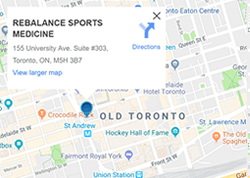Preventing Low Back Injuries in Golf
 The warmer weather means golf enthusiasts are out in full force and trying to make the most of the short Canadian golf season. Unfortunately, the large majority of golfers will suffer from a low back injury. To prevent this from happening to you, it’s important to take care of your spine and hips on and off the course!
The warmer weather means golf enthusiasts are out in full force and trying to make the most of the short Canadian golf season. Unfortunately, the large majority of golfers will suffer from a low back injury. To prevent this from happening to you, it’s important to take care of your spine and hips on and off the course!
How does golf increase your risk of low back injury?
Studies indicate that low back injuries account for 23.7 – 34.5% of all golf-related injuries being the most common type of injury in the sport. During a golf swing, the low back experiences downward compression, side-to-side bending, and back-to-front shearing forces. Peak compressive force through the low back during golf swing can be as much as eight times the body weight. Poor swing mechanics shown in amateur golfers can add more side-to-side bending and back-to-front shearing forces by 80%, which can ultimately result in low back strain or injury.
Types of Swings
There are two types of golf swing: classic golf swing that was predominant during the early 1900s and modern swing that was introduced by Jack Nicklaus in the 1960s. The main difference between the two swings is large pelvic and shoulder rotation in the classic back swing opposed to smaller pelvic rotation relative to the shoulder in the modern back swing. The advantage of the modern swing was increased power generation due to coiling effect of the trunk compared to the classic swing1.
Another difference between the two swings can be found in follow-through. The modern swing shows hyperextension (bending backward too far) and upward momentum during follow-through, opposed to the classic swing maintaining relatively neutral spine and forwards body momentum during follow-through. The low back hyperextension and side-bending in the modern swing follow-through are potential risk factors to developing low back pain. Hence, a third swing type combining the back swing of the modern swing, and the follow-through of the classic swing is increasing in popularity1.
Prevention Strategies
- Learn how to improve your swing mechanics by taking golf lessons with a qualified golf instructor
- Warm up your body before you start a round of golf. Focus on movements that involve shoulder rotations, spine twisting, lunging and weight shifting. Also, practice swinging with varying ranges of motion and with different clubs to prepare your body for the demands that will be placed on it. Your practice should involve swinging with both left and right sides for muscle balance and co-ordination.
- Participate in yoga or self-stretch activities in order to stretch your shoulders, spine and hips on days that you are not playing golf. This will ensure that your body is flexible enough to absorb shock and rotate effectively while you play.
- Get the right equipment. Consult an expert to ensure your golf clubs are matched properly to your body build and size.
- Visit a trusted physiotherapist or chiropractor if you are experiencing any pain, stiffness or weakness that is affecting your golf game.
In my clinical opinion, decreased mobility in the mid-back and hips are the most common contributing factor for developing a low back injury in golf. Stiffness in the mid back and hips means that excessive motion goes through the low back, predisposing one to low back injuries. Contact us today and book an appointment with our physiotherapists or chiropractors who will use their treatment techniques to help you move better in your mid back and hips. We can also help you to develop a conditioning and stretching program that you can use off the golf course in order to improve your performance and stay injury free!
References:
- 1. McHardy, A., Pollard, H, & Luo, K. (2006). Golf injuries: a review of the literature. Sports Med. 36(2):171-187.
Rebalance Toronto
Rebalance Sports Medicine is a multidisciplinary clinic in downtown Toronto offering physiotherapy, chiropractic, registered massage therapy, sports medicine, naturopathy, Pilates and more.



 What to Expect From Your First Physiotherapy Visit
What to Expect From Your First Physiotherapy Visit The Benefits of Fascial Stretch Therapy [Demo]
The Benefits of Fascial Stretch Therapy [Demo] How Does Physiotherapy Work?
How Does Physiotherapy Work? Best Exercises for Low Back Pain
Best Exercises for Low Back Pain